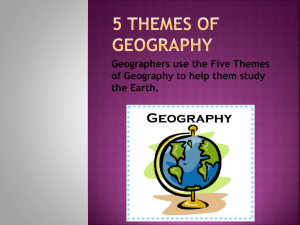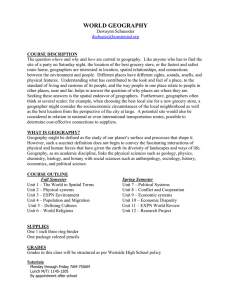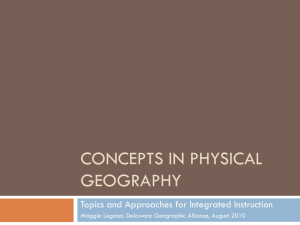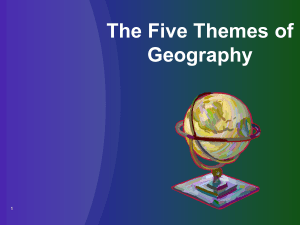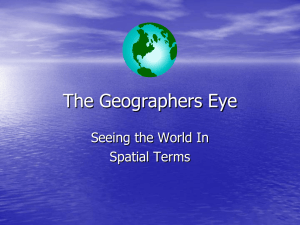Humanistic & Marxist Geography: Evolution of Geographical Thought
advertisement
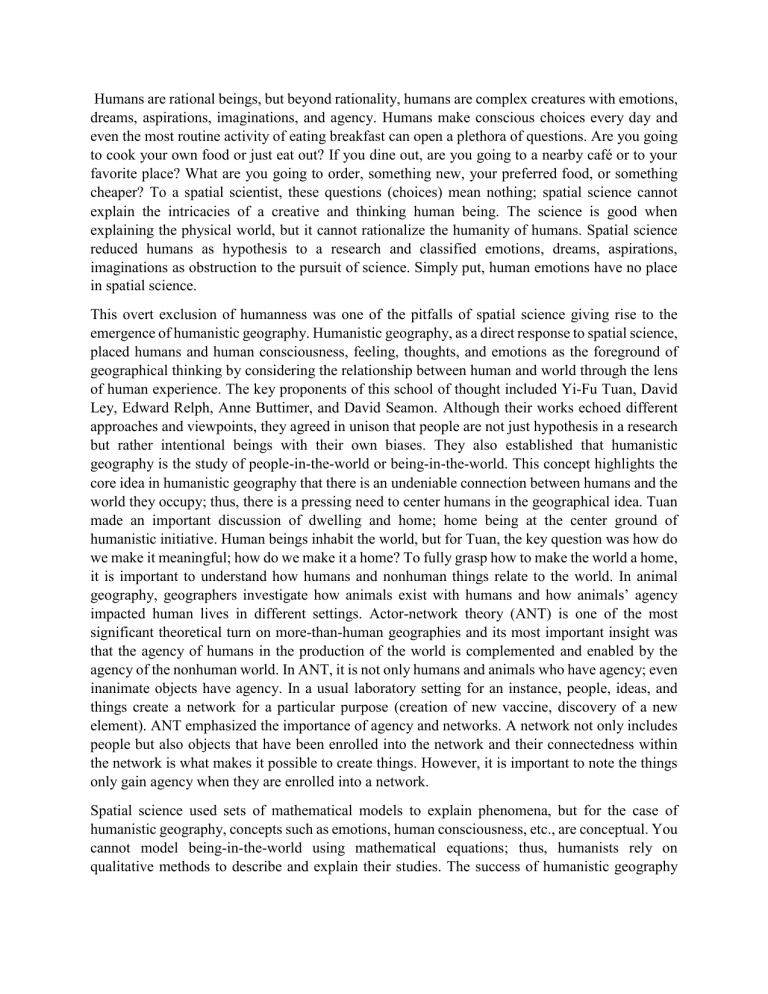
Humans are rational beings, but beyond rationality, humans are complex creatures with emotions, dreams, aspirations, imaginations, and agency. Humans make conscious choices every day and even the most routine activity of eating breakfast can open a plethora of questions. Are you going to cook your own food or just eat out? If you dine out, are you going to a nearby café or to your favorite place? What are you going to order, something new, your preferred food, or something cheaper? To a spatial scientist, these questions (choices) mean nothing; spatial science cannot explain the intricacies of a creative and thinking human being. The science is good when explaining the physical world, but it cannot rationalize the humanity of humans. Spatial science reduced humans as hypothesis to a research and classified emotions, dreams, aspirations, imaginations as obstruction to the pursuit of science. Simply put, human emotions have no place in spatial science. This overt exclusion of humanness was one of the pitfalls of spatial science giving rise to the emergence of humanistic geography. Humanistic geography, as a direct response to spatial science, placed humans and human consciousness, feeling, thoughts, and emotions as the foreground of geographical thinking by considering the relationship between human and world through the lens of human experience. The key proponents of this school of thought included Yi-Fu Tuan, David Ley, Edward Relph, Anne Buttimer, and David Seamon. Although their works echoed different approaches and viewpoints, they agreed in unison that people are not just hypothesis in a research but rather intentional beings with their own biases. They also established that humanistic geography is the study of people-in-the-world or being-in-the-world. This concept highlights the core idea in humanistic geography that there is an undeniable connection between humans and the world they occupy; thus, there is a pressing need to center humans in the geographical idea. Tuan made an important discussion of dwelling and home; home being at the center ground of humanistic initiative. Human beings inhabit the world, but for Tuan, the key question was how do we make it meaningful; how do we make it a home? To fully grasp how to make the world a home, it is important to understand how humans and nonhuman things relate to the world. In animal geography, geographers investigate how animals exist with humans and how animals’ agency impacted human lives in different settings. Actor-network theory (ANT) is one of the most significant theoretical turn on more-than-human geographies and its most important insight was that the agency of humans in the production of the world is complemented and enabled by the agency of the nonhuman world. In ANT, it is not only humans and animals who have agency; even inanimate objects have agency. In a usual laboratory setting for an instance, people, ideas, and things create a network for a particular purpose (creation of new vaccine, discovery of a new element). ANT emphasized the importance of agency and networks. A network not only includes people but also objects that have been enrolled into the network and their connectedness within the network is what makes it possible to create things. However, it is important to note the things only gain agency when they are enrolled into a network. Spatial science used sets of mathematical models to explain phenomena, but for the case of humanistic geography, concepts such as emotions, human consciousness, etc., are conceptual. You cannot model being-in-the-world using mathematical equations; thus, humanists rely on qualitative methods to describe and explain their studies. The success of humanistic geography gave authority to interviews, oral history, participant observation, textual and visual analysis, and self-reflection as viable qualitative methods for contemporary geographical scholars. Although humanistic geography was a direct response to spatial science, humanistic geographers drew its inspiration from existentialism and most significantly to phenomenology. Phenomenology is concerned with finding the fundamental nature of things. For phenomenology, it is of paramount importance to understand first what it is you are studying; thus, the question of “what is a place?” became one of the most important theoretical engagements in humanistic geography. In spatial science, a place is an objective point anywhere in the world that can be located thru coordinates. For a humanist, a place is much more layered; it is also a physical location that can be traced using coordinates, but beyond that, a place has a meaning. My workplace in Malate is a place you can easily find the coordinates using Google maps or Google Street View, but for me, it has been a second home for eight years. In this place, I experience rollercoaster of emotions from simple triumphs to disappointments. This notion of place in humanistic geography describes the relationship between people and the world in the lens of human experience. The drastic changes brought about by rapid industrialization and globalization in the past centuries created various societal issues. Spatial science and humanistic geography have shortcomings when it comes to addressing issues involving social injustices, equality, exploitation, and oppression. Geographers felt that their work was irrelevant because they cannot help in solving these issues; they wanted to make a difference. Collectively, geographers agreed that there was a world outside the boundaries of academic institutions and that they have obligation beyond the classrooms. This shift in consciousness brought about an alternative to spatial science and humanism – Marxism or Marxist geography. Marxist geographers used the insights of Marxist theory into the geographic discipline not only to further explain and understand the world, but also to change it. Key to the discussion of Marxist geography is the debate of production of space (uneven development) and production of nature. In Marxist geography, space is not just a location or a physical place where things happen, but a product of human interaction and has a pivotal role in the modes of production such as capitalism. We are living in a capitalist world partly because of geography. But the question remains “how is geography helping capitalism to thrive?”. Marx’s study of capitalism showed that capitalism experiences periodic crises, the Great Depression of the 1930s, the 1997 Asian financial crisis, the 2007-2008 crisis, among many others, but capitalism proved to be buoyant despite these downturns. The answer according to Marxist geographers lies in geography. The goal of capitalism is to produce profit thru lowering production costs. This can be achieved by investing in new technologies, new machineries, or new fixed assets such as factories and buildings. These investments to fixed assets will prove to be effective in boosting profits in the short-run, but in the long run, when market saturates and competitions begin to surface, these invested capital can be more of a disadvantage for future developments causing profits to dwindle. If this happens, capitalist companies will try to find another ideal geographical location, preferably places where labor costs are cheaper or where there is an untapped market, to invest in that will allow generation of maximum profits. This is one way out of crisis and why capitalism continues to thrive; there is a constant creation of new geography. This is termed as spatial fix. Thus, it is inherent in the workings of capitalism that there are developed areas and less developed. This is the general process of uneven development. These are familiar stories we have already heard before. US companies transferring production in Asian countries to take advantage of cheaper labor costs. Another geographical theme that Marxist geographers took head on is the production of nature. At first glance, you will ask how nature can be produced when it is just there, and it is beyond human control. Neil Smith provided an argument of two natures. The first nature is the primordial nature, the nature that is beyond the influence of humans. The second nature is socially produced. First nature is transformed to second nature thru labor and capital to adhere to the demand of capitalism of producing profits. Agricultural lands in the rural escape even though far from the hustle and bustle of cities are considered as second nature because they are manipulated by human labor and capital. Our national parks no matter how seemingly pristine and well protected are still socially produced. These parks still fall in the pretext of capitalism because they earn profits. Perhaps, the most interesting discussion of production of nature in Marxist geography is soil erosion; how this seemingly natural process is influenced by capitalism. Not all soils are of equal value. Some lands are valuable because they produce raw materials for production. Some are important for vegetation and agriculture. Others can be marginally valuable or inconsequential at all; thus, the natural process of soil erosion as argued by Marxist geographers is not a consequence of natural causes or human action but a product of the structure of the global economy under capitalism. In conclusion, the geographical thinking has evolved through time. It was able to resolve the criticism that it is unscientific through the arrival of spatial science. It was able to absolve itself from the critique that it is too scientific through the development of humanistic geography. But perhaps, the boldest of this geographical thought is the Marxist geography because of its active advocacy for activism and dismantling the status quo. Marxist geography not only tried to explain the connection of human and the world by considering capitalism and other socio-spatial arrangements. Its end goal is to reform the system. Upon reading the given texts, several questions crossed my mind. First, was Marxist geographers successful in challenging and reforming the status quo? It was 1973 when David Harvey wrote that the world is facing economic problem, urban problem, and international trade. Forty-seven years after, we are still faced with the same kind of problems if not worse. Probably the answer to that question is a no. Second, if Marxist geographers were able to pinpoint the role of geography in capitalism, perhaps geography is also the key to demolish capitalism, but the bigger question is how? Finally, are we going to see through the end of these social inequalities? Maybe, only time can tell.
